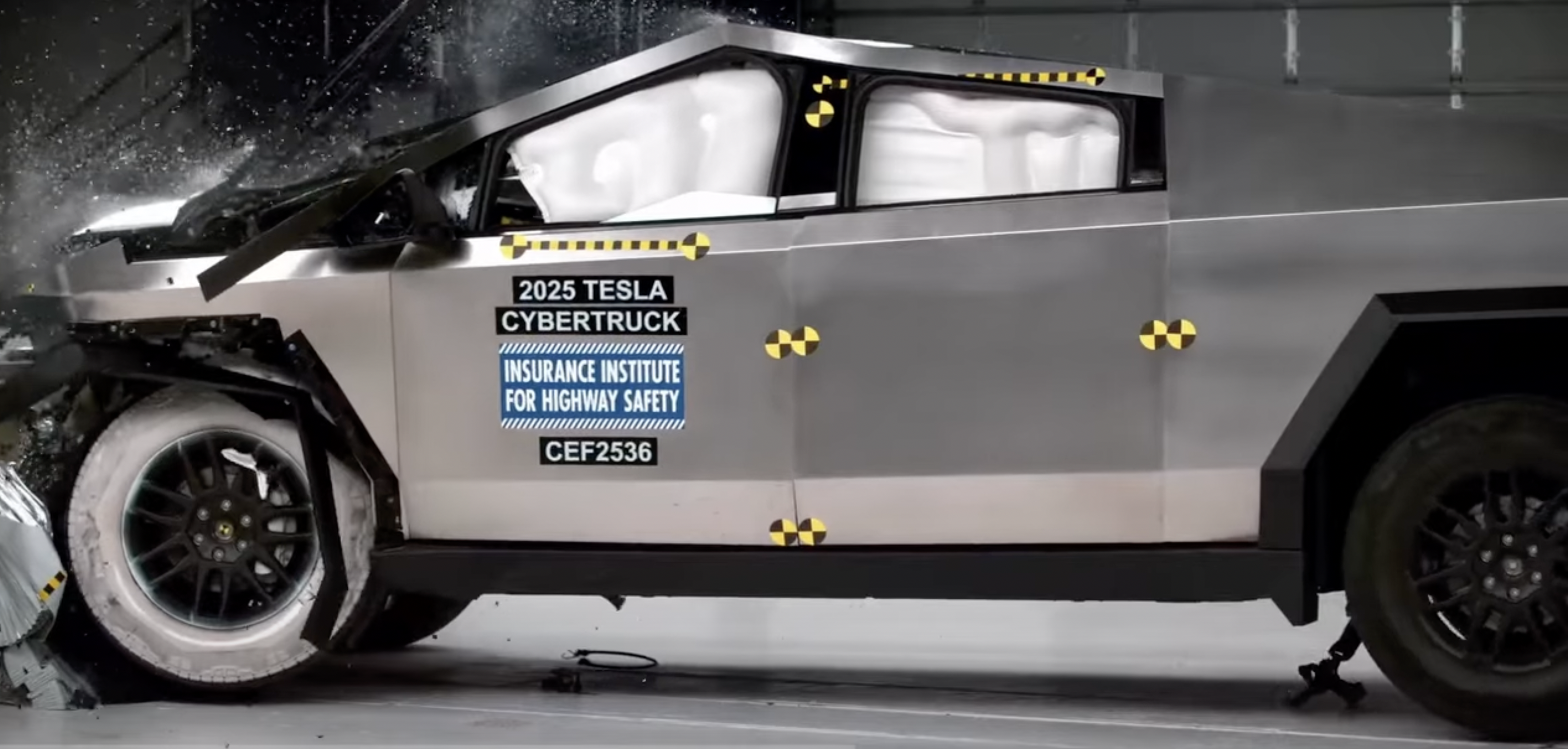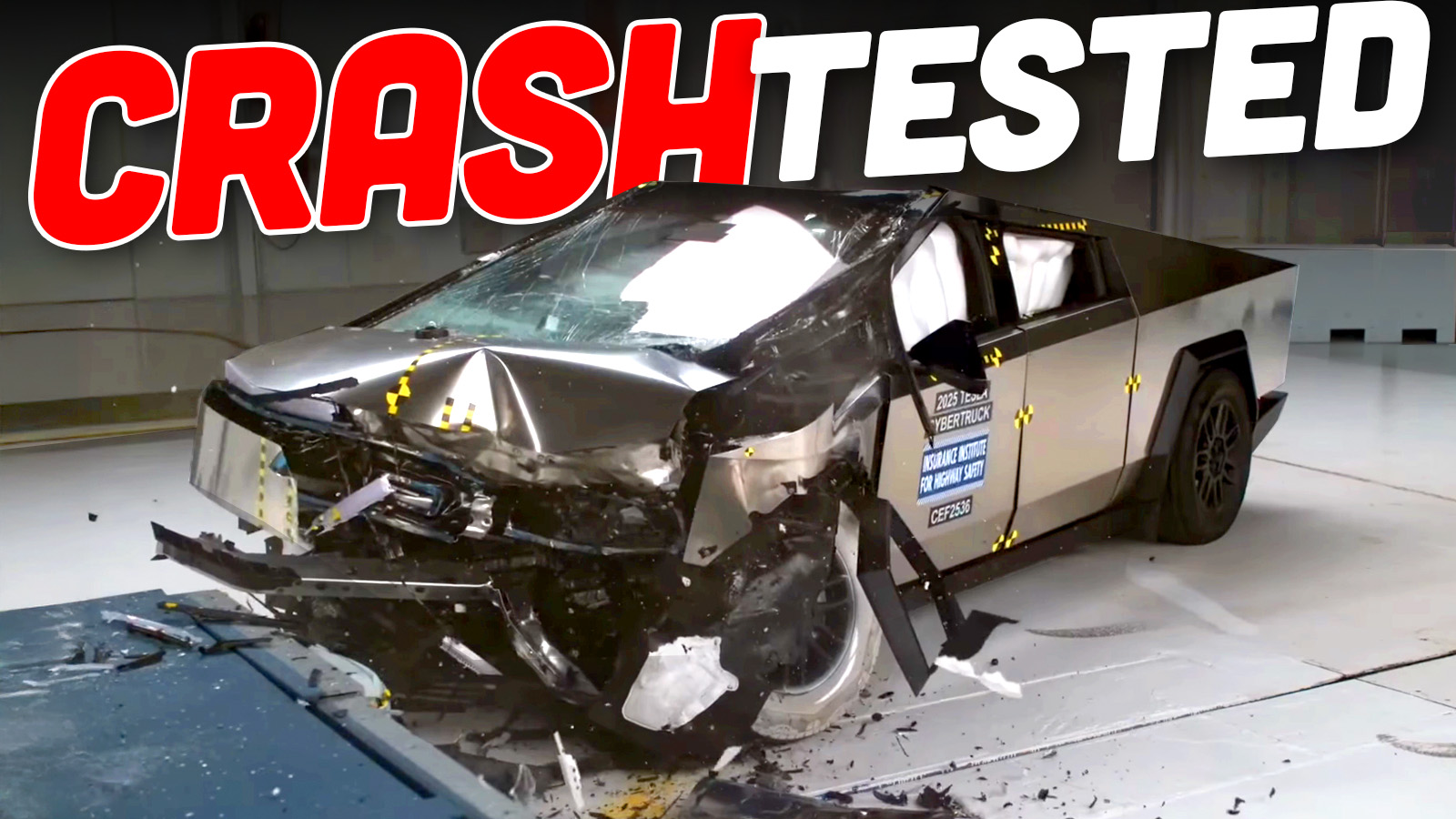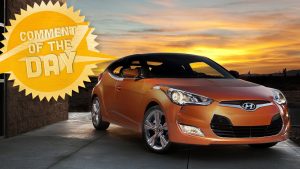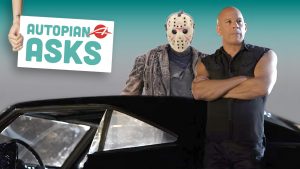When the Tesla Cybertruck came out, it drew criticism from pretty much every angle, one of which was the fact that it had not been crash tested by an independent entity. Though Tesla said the vehicle was safe, even showing the world some crash test footage — and the government has requirements in place that ensure that an egregiously unsafe vehicle doesn’t hit our streets — people wanted to see the cold, hard data from a third party like the U.S. government or IIHS. We’ve already seen the Cybertruck get five stars by the government; now IIHS data is coming.
The high profile nature of the Cybertruck led the world to realize that not every car on American streets gets crash tested, with many publications digging into the “why” so as to enlighten curious readers. Here’s Consumer Reports‘…report:
Most of the vehicles without ratings are low-volume models, sports cars, luxury vehicles, or large vans. The expense is too great for NHTSA and the IIHS to test all vehicles, so choices are made based on car sales volume and testing budgets. Some untested models are new or redesigned and merely waiting in line to be evaluated. About 97 percent of all new vehicles sold are crash-test rated by one or both of the independent organizations.
[…]
To be certified for sale, every new model sold in the U.S. must be crash-tested internally to ensure minimum federal safety standards are met. But a publicly available rating isn’t required.
[…]
For example, neither NHTSA nor the IIHS have plans to test the Cybertruck. “While it has certainly created a lot of buzz, it’s unlikely we would invest resources to test it unless it were selling in numbers comparable with other popular large pickups,” IIHS spokesperson Joe Young says.
By the way, I didn’t believe that last bit for a second. There was absolutely, positively no way in hell IIHS was going to forego crash testing the Cybertruck. IIHS is an organization that loves publicity; they have a YouTube channel with over 300,000 followers, an Instagram with nearly 130,000, a media arm that is extremely responsive (and honestly, excellent), and they churn out press releases and take interviews like an organization that wants to stay at the forefront of your mind.
Also, remember this amazing publicity stunt?
I’ve been to IIHS a number of times, as I attended college up the street at UVA. They’re a bunch of uber-nerds, but the cool kind. They also love being in front of cameras, so the idea that a high-profile vehicle — especially one whose lack of crash tests the entire world was talking about — was going to avoid entering their Vehicle Research Center in Ruckersville was a bit silly. So I shot an email off to them back in December and heard this back: “We don’t have any current plans to test it. We only plan out a few months in advance, however, so that can always change.”
I knew it would change, and indeed it did. The Tesla Cybertruck truck crash test results are now imminent! IIHS provided a teaser seven weeks ago on its Instagram:
And yesterday, “EV/space/tech news” persona and Twitter investor Sawyer Merritt tweeted this video showing IIHS’s Moderate Overlap frontal crash test (40% of the front hits rigid barrier at 40 mph — much harder than the full-overlap 35 mph frontal and other government crash tests, which have stagnated):
We don’t have any results yet, but from where I sit, things look good. Of course, it’s hard to tell without seeing inside the cabin if there was any intrusion, and more importantly, we’d need to see the forces imparted on the dummies (or, better yet, just let IIHS interpret all that for us, which they will). But outwardly, it sure looks like at least the “structure and safety cage” element of the Moderate Overlap crash test should get good marks.

When the Cybertruck came out, many seemed concerned that it would be so stiff it would lack a crumple zone, and the impulse from the crash would be bad for the occupants; I’m not sure that that appears to be a huge issue based on what I’m seeing above, though the test results will tell us what we need to know, plus it will be cool to see what other tests IIHS puts the truck through. I’d really like to see the Cybertruck put through the gauntlet, specifically the 25%-frontal Small Overlap Rigid Barrier Test (SORB), because that’s the big-dog of the crash-test world.
UPDATE
IIHS just released this statement:
IIHS tested the Cybertruck last month in our updated moderate overlap crash test as well as several of our nondestructive crash avoidance tests. It’s part of a test group that involves other EVs like the F-150 Lightning and Volkswagen ID. Buzz. Tests are still underway for the ID. Buzz, and we plan to release everything together, likely in late August or early September.
The day of the Cybertruck test we also happened to be hosting about 25 science curriculum supervisors as part of promoting our Crash Science in the Classroom educational website. This event was hosted in collaboration with a company called PocketLab that makes sensors and other classroom tools. PocketLab used the video yesterday as part of a separate virtual event for science teachers to recap the June event. I hadn’t realized the link would be publicly available, so thanks for pointing that out. I’ve asked them to remove it for now since we don’t yet have a rating available, and we would always prefer viewers to have the full story all at once.
Top graphic image via The PocketLab/YouTube
UPDATE:
Video has been deleted, but here it is on Twitter. And, at least for now, here’s one on YouTube from YouTube channel Gear Musk:









“forces imparted on the dummies”
So there’s really no change once these are purchased…
“Hey, look I spent hard earned cash on a…Cybertruck!”
Fred Sanford: “You big DUMMY!”
Not a crash test expert and I’m super interested to see the outcome. I will say that the crumple seemed less than I would have thought and the dummy got some major head/neck deflection going on, but we’ll see what the sensors say…
Makes you realize how thin those steel panels are and how they could fly off the car under different kinds of crashes. I wonder what a flying piece of stainless steel would do to a bystander.
That caught my attention as well. I don’t care for this thing so I’ve never bothered to look into how it’s made, but I was surprised that the nose plate was just a very thin strip of stainless that looks like it is held into place with adhesive (blue stuff on the back). Same with the a-pillar trim and presumably roof trim as well. They’re just tacked on it looks.
It means nothing structurally, but I presumed that they would have been used as part of the support structure instead of just being an applique. It seems to hold up reasonably well regardless. The days of anything folding up like they used to are thankfully gone.
I bet Tesla could easily replace the stainless panels with metal or plastic panels and save a shitload in material costs. If they ever do it, you know they are finally throwing in the towel on this design fiasco.